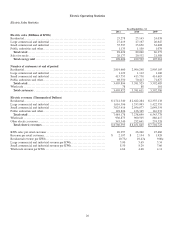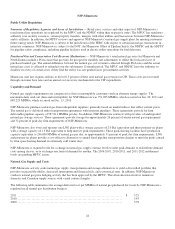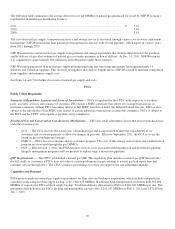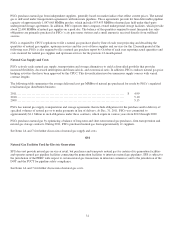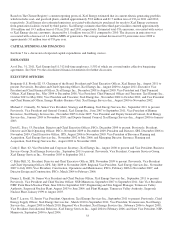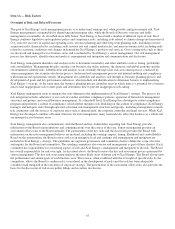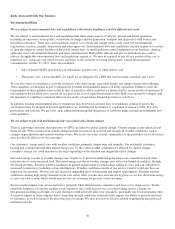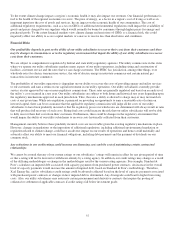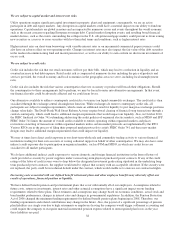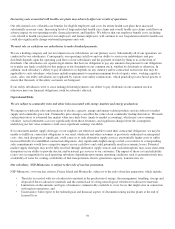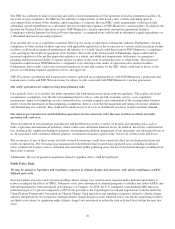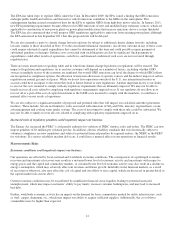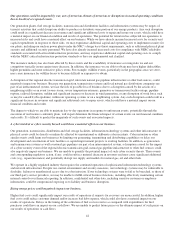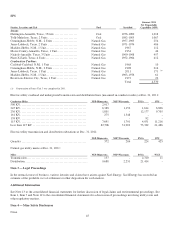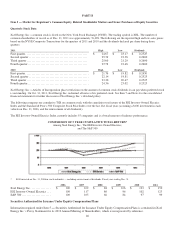Xcel Energy 2011 Annual Report Download - page 46
Download and view the complete annual report
Please find page 46 of the 2011 Xcel Energy annual report below. You can navigate through the pages in the report by either clicking on the pages listed below, or by using the keyword search tool below to find specific information within the annual report.36
Risks Associated with Our Business
Environmental Risks
We are subject to environmental laws and regulations, with which compliance could be difficult and costly.
We are subject to environmental laws and regulations that affect many aspects of our past, present and future operations,
including air emissions, water quality, wastewater discharges and the generation, transport and disposal of solid wastes and
hazardous substances. These laws and regulations require us to obtain and comply with a wide variety of environmental
registrations, licenses, permits, inspections and other approvals. Environmental laws and regulations can also require us to restrict
or limit the output of certain facilities or the use of certain fuels, to install pollution control equipment at our facilities, clean up
spills and correct environmental hazards and other contamination. Both public officials and private individuals may seek to
enforce the applicable environmental laws and regulations against us. We may be required to pay all or a portion of the cost to
remediate (i.e., clean-up) sites where our past activities, or the activities of certain other parties, caused environmental
contamination. At Dec. 31, 2011, these sites included:
• Sites of former MGPs operated by our subsidiaries, predecessors, or other entities; and
• Third party sites, such as landfills, for which we are alleged to be a PRP that sent hazardous materials and wastes.
We are also subject to mandates to provide customers with clean energy, renewable energy and energy conservation offerings.
These mandates are designed in part to mitigate the potential environmental impacts of utility operations. Failure to meet the
requirements of these mandates may result in fines or penalties, which could have a material effect on our results of operations. If
our regulators do not allow us to recover all or a part of the cost of capital investment or the O&M costs incurred to comply with
the mandates, it could have a material effect on our results of operations, financial position or cash flows.
In addition, existing environmental laws or regulations may be revised, and new laws or regulations seeking to protect the
environment may be adopted or become applicable to us, including but not limited to, regulation of mercury, NOx, SO2, CO2,
particulates and coal ash. We may also incur additional unanticipated obligations or liabilities under existing environmental laws
and regulations.
We are subject to physical and financial risks associated with climate change.
There is a growing consensus that emissions of GHGs are linked to global climate change. Climate change creates physical and
financial risk. Physical risks from climate change include an increase in sea level and changes in weather conditions, such as
changes in precipitation and extreme weather events. We do not serve any coastal communities so the possibility of sea level rises
does not directly affect us or our customers.
Our customers’ energy needs vary with weather conditions, primarily temperature and humidity. For residential customers,
heating and cooling represent their largest energy use. To the extent weather conditions are affected by climate change,
customers’ energy use could increase or decrease depending on the duration and magnitude of the changes.
Increased energy use due to weather changes may require us to invest in additional generating assets, transmission and other
infrastructure to serve increased load. Decreased energy use due to weather changes may affect our financial condition, through
decreased revenues. Extreme weather conditions in general require more system backup, adding to costs, and can contribute to
increased system stress, including service interruptions. Weather conditions outside of our service territory could also have an
impact on our revenues. We buy and sell electricity depending upon system needs and market opportunities. Extreme weather
conditions creating high energy demand on our own and/or other systems may raise electricity prices as we buy short-term energy
to serve our own system, which would increase the cost of energy we provide to our customers.
Severe weather impacts our service territories, primarily when thunderstorms, tornadoes and snow or ice storms occur. To the
extent the frequency of extreme weather events increases, this could increase our cost of providing service. Changes in
precipitation resulting in droughts or water shortages could adversely affect our operations, principally our fossil generating units.
A negative impact to water supplies due to long-term drought conditions could adversely impact our ability to provide electricity
to customers, as well as increase the price they pay for energy. We may not recover all costs related to mitigating these physical
and financial risks.


